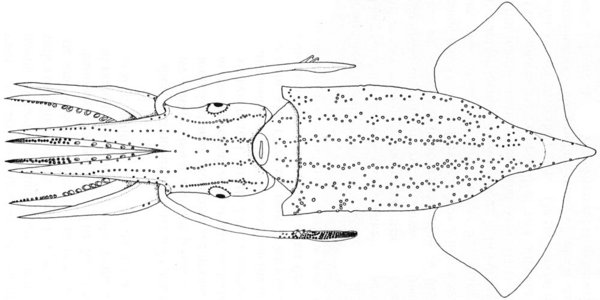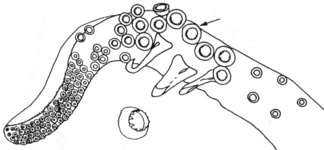Abralia marisarabica
Kotaro TsuchiyaIntroduction
A. marisarabica is possibly the smallest-sized species in the genus. It is easily recognized by its small mature-size of less than 25mm DML, the small number of club hooks (usually 2), the longitudinal stripe photophore arrangement on the ventral mantle and head, and more than five, silvery eye photophores. This species is similar to A. fasciolata in the mantle photophore arrangement, buccal rappet connectives and eye photophores, but is easily distinguishable by its smaller mature size, and the smaller number of integumental photophores on the mantle.
Characteristics
- Tentacle clubs
- Two or three hooks on ventral side.
- Two rows of large suckers on dorsal side of manus.
- Hectocotylus
- Right ventral arm of male hectocotylized.
- Hectocotylus with two very different-sized flaps.
- Large proximal flap bilobed.
- Eye Photophores
- Five silvery organs with three to five minute additional organs in between.

- Integumental Photophores
- Ventral mantle with six longitudinal stripes of integumental organs.
- Ventral head with seven longitudinal stripes of integumental organs; unpaired middle stripe with few organs.
- Buccal connectives.
- Buccal-support connectives attached to the dorsal side of Arms III (DDDD-type).
Distribution
Geographical distribution
This species is considered to be endemic to the oceanic waters of the Arabian Sea (Nesis and Nikitina 1988; Piatkowski and Welch, 1991).
References
Nesis, K.N. and Nikitina, 1988.
Piatkowski, U. and Welch,
Okutani, T. 1983. Abralia marisarabica, a new enoploteuthid squid from the Arabian Sea (Cephalopoda: Oegopsida). Bulletin of the National Science Museum, (series A)9(4):161-168
Title Illustrations

| Scientific Name | Abralia marisarabica |
|---|---|
| Location | Arabian Sea |
| Reference | Okutani, T. 1983. Abralia marisarabica, a new enoploteuthid squid from the Arabian Sea (Cephalopoda: Oegopsida). Bulletin of the National Science Museum, (series A)9(4):161-168, 14 figures. |
| Sex | Male |
| View | Ventral |
| Size | between 20 and 22 mm ML |
| Collection | NSMT-Mo 31360 |
| Type | Paratype |
| Copyright | © 1983 T. Okutani |
About This Page

Tokyo University of Fisheries, Tokyo, Japan
Page copyright © 2018
All Rights Reserved.
- Content changed 03 November 2013
Citing this page:
Tsuchiya, Kotaro. 2013. Abralia marisarabica . Version 03 November 2013 (under construction). http://tolweb.org/Abralia_marisarabica/19653/2013.11.03 in The Tree of Life Web Project, http://tolweb.org/












 Go to quick links
Go to quick search
Go to navigation for this section of the ToL site
Go to detailed links for the ToL site
Go to quick links
Go to quick search
Go to navigation for this section of the ToL site
Go to detailed links for the ToL site